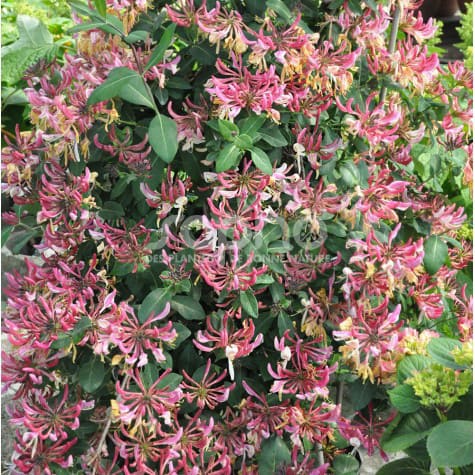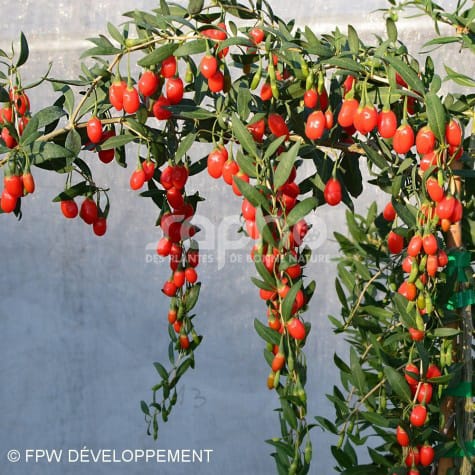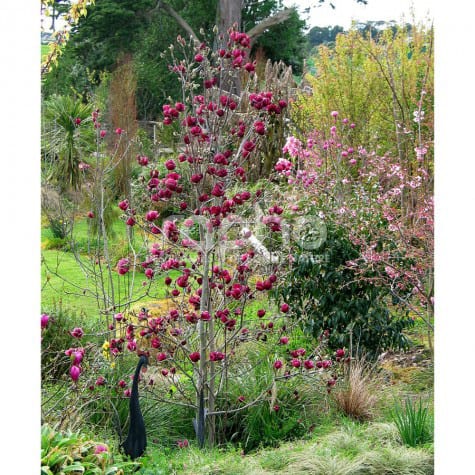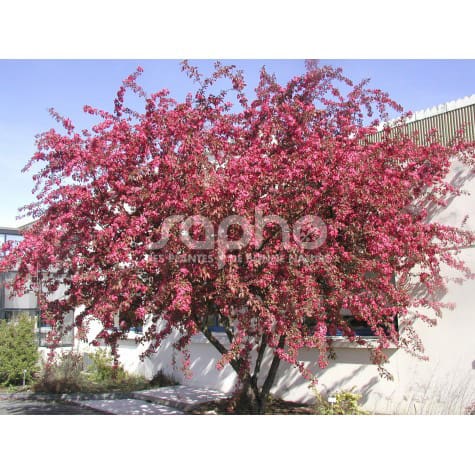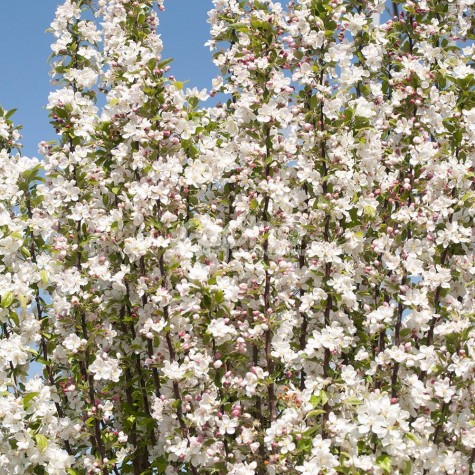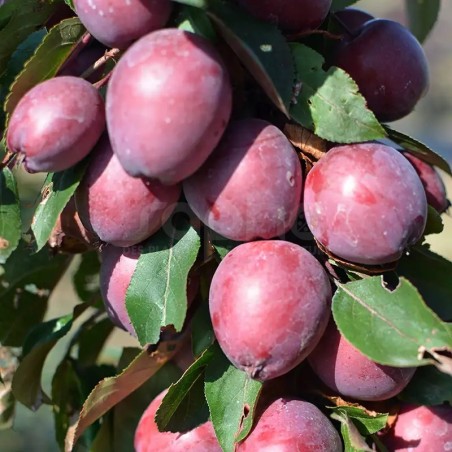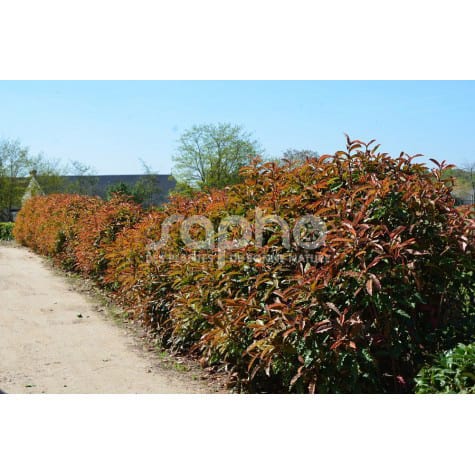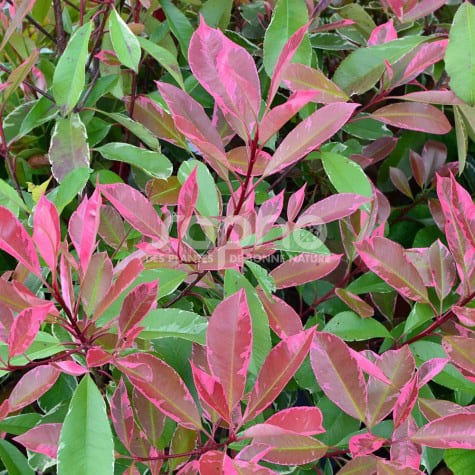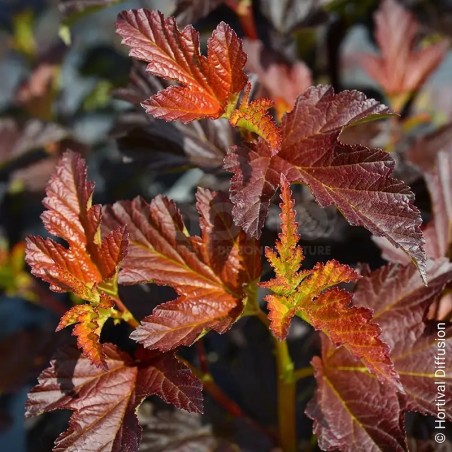Imperial honeysuckle : an avalanche of beautiful red, fragrant flowers.
This selection of climbing honeysuckle of the CAPRILIA ® range derives from the Lonicera periclymenum 'Florida'. Its growth is medium.From mid June to July this flower bearing variety is particularly remarkable due to its big florets over the entire height of the plant. The fragrant flowers are carmine red in the bud stage, getting lighter on opening, turning cream, then yellow before wilting, producing a beautiful contrast.The dark green foliage shows off the flowers to their advantage. It is resistant to black spot, mildew and aphids.To be trained.
Filter By
Foliage
Position
Where to find Sapho plants ?
For young plants
You will find the names of Sapho-licensed nurserymen at the bottom of each variety sheet.
For available plants
Please ask your nursery suppliers.
Each licensed propagator is free to market his young plants to all his customers.
Categories
Menu
All our varieties
A real innovation from French genetics : An easy maintenance goji with sugary sweet berriesPRINCESS TAO® is an exclusively French genetic goji variety, the outcome of the breeding work by FPW DEVELOPPEMENT.The discrete light violet flowering starts at the end of May. It continues in successive waves right through into September, finally reaching the tips of its branches. The fruits form rapidly and simultaneously. When ripe, the berries are beautifully bright red and shiny. The picking from July onwards is easy as the berries are bigger than those of the currently available market varieties. The fruits are sweet, not astringent and can be eaten fresh or dried. Under good conditions the fruit production continues right into November.From the first year of planting, a small quantity of fruit can already be picked.The naturally layered growth makes staking necessary. Thanks to the sweet taste of its fresh berries and needing only little water, as well as being mildew resistant, PRINCESS TAO® links delicacy and easy maintenance.
A compact magnolia, with beautiful bright purple tulips.
'Genie' a cross between M. soulangeana and M. lilliflora 'Nigra', has all the qualities of a good hybrid.Right from the beginning, it is very floriferous, and before the leaves appear, it has very big, stable, bright purple, tulip shaped flowers. They are lightly scented, long-lasting, and can resist temperatures of down to -3°C. In good conditions, a second flowering can bloom in summer.Dense and upright growth, good branching, moderate dimensions (at 10 years of age 3 m high and 1.50 m wide) : an asset, planted in small areas, grows as shrub or tree.
Trophies:
An imperial blooming from an early age
Selected by Vance Hooper, who is the breeder of the fabulous Magnolia ‘GENIE’
Superb flowers over 20 cm large, dark red-pink, lightly scented
Blooms from April with summer reblooming
Flowers abundantly, even on young plants
Moderate-sized tree, perfect for gardens or streets and squares
An ornamental apple tree for the town or the country.This tree is of semi-spreading shape, reaching a height of 3 to 4meters in ten years and has a harmonious form, which it keeps without the necessity of pruning. Its leaves and branches are purple.The violet-pink flowers blossom in April - May along the whole length of the branches, and the purple fruits appear in autumn.COCCINELLA® has also been chosen by the INRAE selectors for its resistance to the major diseases such as fire blight, scab and mildew.Grown to a full standard, COCCINELLA® has the asset of a small town tree; grown in clumps, its foliage and fruit are appreciated in mixed countryside hedges or in shrub borders.
Naturally a STAR since its creation.
This tree is of semi-spreading growth, reaching a height of 3 to 4m in ten years and has a harmonious shape, which it keeps without the necessity of pruning. Its foliage is green.
In April, 'Evereste' covers itself in bright pink flower buds, which bloom as pure white bouquets of flowers. The quality and the abundance of its pollen make it an ideal pollinator, precious for fruit growers (in proportion of 6 - 8% of all varieties of early or semi-early flowering).
The cherry sized fruits are orange with thin red stripes. They apprear in autumn and have the particularity to last well into winter.
'Evereste' has also been chosen by the INRAE selectors for its resistance to the major diseases such as fire blight, scab and mildew.
Nearly a million plants have been sold in Europe since its creation in 1974.
Its ornamental qualities, its reasonable dimensions and its easy care make it an excellent small urban tree if grown full standard; in clumps it is very valuable in the composition of flowering hedges and in shrub borders.
A landmark in the garden!
A columnar habit when young, evolving into a pyramidal form
Young, purple foliage that turns dark green
Spectacular intense red flowering in bud, evolving to carmine pink
Numerous plum-sized, purplish-red fruits with red flesh persist until late autumn
Its initial columnar shape evolves into a pyramid shape with age, making it ideal for small spaces
A long, dazzling and fragrant flowering period!
A clear improvement on the Philadelphus x virginalis group
Flowering all along the branches, from mid-May to the end of summer
Large, full double, pure white flowers, with a more intense fragrance
Very healthy foliage throughout the season
A compact, well-branched, harmonious habit, easy to grow, suitable for gardens (even small ones) and pots
Chocolate coloured and toothed leaves : an original foliage with this new Photinia.The originality of the foliage brings a revival to the Photinia. The leaf blade is ondulated and finely toothed. The young shoots, copper at first, take on the unusual chocolate shade, and then turn dark green.This cultivation, tested in nurseries for several years, performs well: it branches and develops well in containers, its growth is good. Hardy, CRUNCHY® keeps its leaves in winter and has a good resistance to powdery mildew. It is therefore recommended for hedges, with or without clipping.Trophies: FIRST PRICE at FLORMAT - MIFLOR 2014 (Padova - ITALY)
Beautifully mixed colours and an upright and regular formIts variegated foliage brings colour throughout the year. Photinia Louise has also been selected for its vigorous, erect growth and its ample vegetation that's regular, compact and dense. Photinia Louise is a shrub with persistent leaves and changing colours. In spring and autumn the young shoots are bright red spotted with pink.The developing leaves become thick and green, spotted wih creamy white. Its flowers, in May, are quite discreet, forming creamy white umbels. Upkeep is easy as it needs little pruning other than that required by the garden. In a hedge, a mixed bed or as a solitary shrub, 2 to 3 m high, Photinia Louise will enliven a garden throughout the year.
In springtime light, pretty copper shimmering foliage.This shrub is remarkable for its dense, deciduous jagged foliage, with its original orange copper shades in spring, turning to purple in summer and autumn. It prefers a sunny position to develop its beautiful colours.It has bushy habit, dense, stocky with strong, straight branches.Small balls of white flowers bloom from May to June. They are followed by red fruits in summer.DIABLE D'OR® suits well in mixed free hedges. Its copper shimmering in springtime, turning to purple later on makes it very precious for creating seasonal variations in the colours of the hedges foliage. The flowers and fruit add to its ornamental value.
A clear improvement on the famous DIABLE D'OR®
More compact, better branched and easier to grow, with brighter foliage in spring and brighter red fruit
Young shoots of a unique bronze colour with a green then golden heart
Foliage then turns a uniform bronze and remains attractive until autumn
Corymbs of white flowers tinged with pink in May-June, followed by small bright red dried fruits in summer
Ideal in the garden as a living hedge or even in smaller spaces, it can also be used in pots for balconies and terraces

